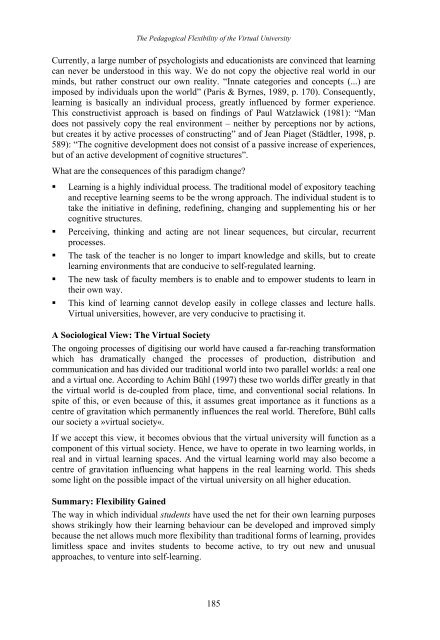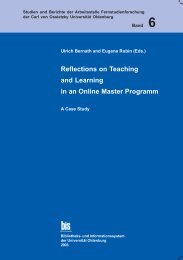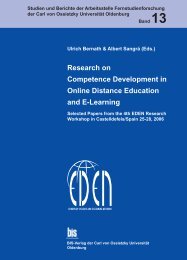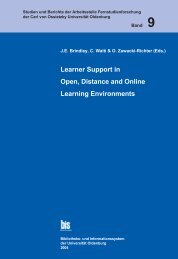Distance Education in Transition - Master of Distance Education ...
Distance Education in Transition - Master of Distance Education ...
Distance Education in Transition - Master of Distance Education ...
You also want an ePaper? Increase the reach of your titles
YUMPU automatically turns print PDFs into web optimized ePapers that Google loves.
The Pedagogical Flexibility <strong>of</strong> the Virtual University<br />
Currently, a large number <strong>of</strong> psychologists and educationists are conv<strong>in</strong>ced that learn<strong>in</strong>g<br />
can never be understood <strong>in</strong> this way. We do not copy the objective real world <strong>in</strong> our<br />
m<strong>in</strong>ds, but rather construct our own reality. “Innate categories and concepts (...) are<br />
imposed by <strong>in</strong>dividuals upon the world” (Paris & Byrnes, 1989, p. 170). Consequently,<br />
learn<strong>in</strong>g is basically an <strong>in</strong>dividual process, greatly <strong>in</strong>fluenced by former experience.<br />
This constructivist approach is based on f<strong>in</strong>d<strong>in</strong>gs <strong>of</strong> Paul Watzlawick (1981): “Man<br />
does not passively copy the real environment – neither by perceptions nor by actions,<br />
but creates it by active processes <strong>of</strong> construct<strong>in</strong>g” and <strong>of</strong> Jean Piaget (Städtler, 1998, p.<br />
589): “The cognitive development does not consist <strong>of</strong> a passive <strong>in</strong>crease <strong>of</strong> experiences,<br />
but <strong>of</strong> an active development <strong>of</strong> cognitive structures”.<br />
What are the consequences <strong>of</strong> this paradigm change?<br />
� Learn<strong>in</strong>g is a highly <strong>in</strong>dividual process. The traditional model <strong>of</strong> expository teach<strong>in</strong>g<br />
and receptive learn<strong>in</strong>g seems to be the wrong approach. The <strong>in</strong>dividual student is to<br />
take the <strong>in</strong>itiative <strong>in</strong> def<strong>in</strong><strong>in</strong>g, redef<strong>in</strong><strong>in</strong>g, chang<strong>in</strong>g and supplement<strong>in</strong>g his or her<br />
cognitive structures.<br />
� Perceiv<strong>in</strong>g, th<strong>in</strong>k<strong>in</strong>g and act<strong>in</strong>g are not l<strong>in</strong>ear sequences, but circular, recurrent<br />
processes.<br />
� The task <strong>of</strong> the teacher is no longer to impart knowledge and skills, but to create<br />
learn<strong>in</strong>g environments that are conducive to self-regulated learn<strong>in</strong>g.<br />
� The new task <strong>of</strong> faculty members is to enable and to empower students to learn <strong>in</strong><br />
their own way.<br />
� This k<strong>in</strong>d <strong>of</strong> learn<strong>in</strong>g cannot develop easily <strong>in</strong> college classes and lecture halls.<br />
Virtual universities, however, are very conducive to practis<strong>in</strong>g it.<br />
A Sociological View: The Virtual Society<br />
The ongo<strong>in</strong>g processes <strong>of</strong> digitis<strong>in</strong>g our world have caused a far-reach<strong>in</strong>g transformation<br />
which has dramatically changed the processes <strong>of</strong> production, distribution and<br />
communication and has divided our traditional world <strong>in</strong>to two parallel worlds: a real one<br />
and a virtual one. Accord<strong>in</strong>g to Achim Bühl (1997) these two worlds differ greatly <strong>in</strong> that<br />
the virtual world is de-coupled from place, time, and conventional social relations. In<br />
spite <strong>of</strong> this, or even because <strong>of</strong> this, it assumes great importance as it functions as a<br />
centre <strong>of</strong> gravitation which permanently <strong>in</strong>fluences the real world. Therefore, Bühl calls<br />
our society a »virtual society«.<br />
If we accept this view, it becomes obvious that the virtual university will function as a<br />
component <strong>of</strong> this virtual society. Hence, we have to operate <strong>in</strong> two learn<strong>in</strong>g worlds, <strong>in</strong><br />
real and <strong>in</strong> virtual learn<strong>in</strong>g spaces. And the virtual learn<strong>in</strong>g world may also become a<br />
centre <strong>of</strong> gravitation <strong>in</strong>fluenc<strong>in</strong>g what happens <strong>in</strong> the real learn<strong>in</strong>g world. This sheds<br />
some light on the possible impact <strong>of</strong> the virtual university on all higher education.<br />
Summary: Flexibility Ga<strong>in</strong>ed<br />
The way <strong>in</strong> which <strong>in</strong>dividual students have used the net for their own learn<strong>in</strong>g purposes<br />
shows strik<strong>in</strong>gly how their learn<strong>in</strong>g behaviour can be developed and improved simply<br />
because the net allows much more flexibility than traditional forms <strong>of</strong> learn<strong>in</strong>g, provides<br />
limitless space and <strong>in</strong>vites students to become active, to try out new and unusual<br />
approaches, to venture <strong>in</strong>to self-learn<strong>in</strong>g.<br />
185





